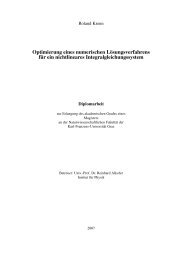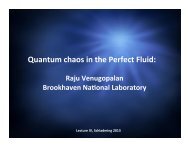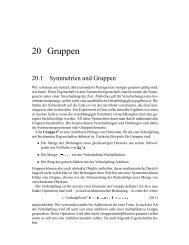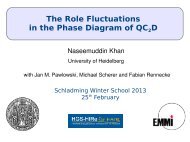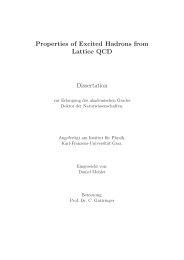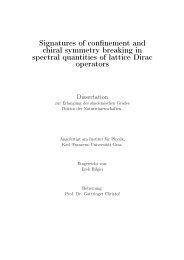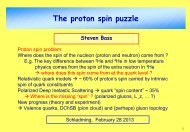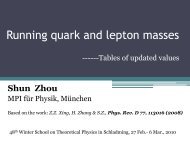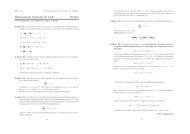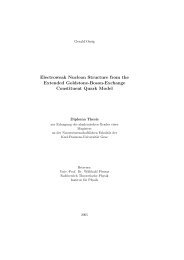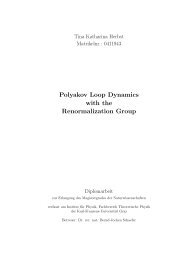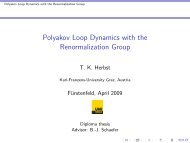The QCD Quark Propagator in Coulomb Gauge and - Institut für Physik
The QCD Quark Propagator in Coulomb Gauge and - Institut für Physik
The QCD Quark Propagator in Coulomb Gauge and - Institut für Physik
You also want an ePaper? Increase the reach of your titles
YUMPU automatically turns print PDFs into web optimized ePapers that Google loves.
Chapter 3. Remarks on <strong>QCD</strong> <strong>in</strong> <strong>Coulomb</strong> <strong>Gauge</strong> 29<br />
C 0 C 1 C 2<br />
. . .<br />
Figure 3.1: <strong>The</strong> space of gauge field configurations is divided <strong>in</strong> regions C n depend<strong>in</strong>g<br />
on the number n of negative eigenvalues of the Faddeev-Popov operator. On each s<strong>in</strong>gle<br />
boundary this operator possess a non-trivial zero mode.<br />
C 1 . Gribov hoped that such relations hold for general gauge transformations <strong>and</strong> that the<br />
configurations outside of C 0 are merely copies (Gribov copies) <strong>and</strong> therefore redundant.<br />
In order to get rid of the ambiguities he suggested to restrict functional <strong>in</strong>tegrations <strong>in</strong><br />
the space of gauge configurations to the Gribov region C 0 . <strong>The</strong> functional <strong>in</strong>tegrals should<br />
be cut off at the boundary, where the lowest non-trivial eigenvalue of the Faddeev-Popov<br />
operator vanishes, also known as the first Gribov horizon.<br />
Further studies showed that <strong>in</strong> the region C 0 there are still Gribov copies present.<br />
This can be illum<strong>in</strong>ated by follow<strong>in</strong>g the gauge fix<strong>in</strong>g procedure of Zwanziger [Zwa82]. It<br />
consists of choos<strong>in</strong>g elements g of the gauge group m<strong>in</strong>imis<strong>in</strong>g the functional<br />
∫<br />
F A [g] = d 3 x tr[A g (x) · A g (x)] , g = exp{ig 0 α a T a } , (3.73)<br />
which is the L 2 norm of the potential along the gauge orbit. Exp<strong>and</strong><strong>in</strong>g to second order<br />
<strong>in</strong> the parameter α gives<br />
∫<br />
∫<br />
F A [g] = F A [1] + 2 d 3 x tr[∂ i A i (x)α(x)] + d 3 xtr[α † (x)(−∂ i D i )α(x)] + O(α 3 ) . (3.74)<br />
We recognise that for a m<strong>in</strong>imum of (3.73) we have transversality of the potential ∂ i A a i = 0<br />
<strong>and</strong> positivity of the Faddeev-Popov operator −∇·D[A g ] ≥ 0, because the Hessian matrix<br />
is positive at a m<strong>in</strong>imum. <strong>The</strong> set of these m<strong>in</strong>ima is by def<strong>in</strong>ition the Gribov region C 0 ,<br />
which is often denoted by Ω. S<strong>in</strong>ce on each gauge orbit there may be more than one local<br />
m<strong>in</strong>imum there is obviously room for gauge copies <strong>in</strong> Ω.<br />
<strong>The</strong> rema<strong>in</strong><strong>in</strong>g gauge copies <strong>in</strong> the Gribov region can be elim<strong>in</strong>ated with the help of<br />
an improved gauge condition. Instead of the Gribov region one considers the set of all<br />
absolute m<strong>in</strong>ima, which is obta<strong>in</strong>ed by m<strong>in</strong>imis<strong>in</strong>g the norm (3.73) along the gauge orbits.<br />
It is called the fundamental modular region <strong>and</strong> is denoted by Λ. Functional <strong>in</strong>tegration



